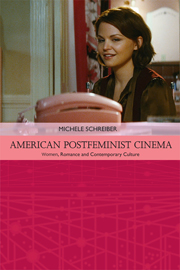Book contents
- Frontmatter
- Contents
- Acknowledgments
- List of Illustrations
- Introduction: Women, Postfeminism and Romance
- 1 ‘Both Glad and Sorry’: Romance Cycles and Women's Politics
- 2 Pragmatism vs. Sentimentality: Amelioration in the Postfeminist Cycle
- 3 Past vs. Present: Temporality in the Postfeminist Cycle
- 4 Sexy vs. Funny: Sexuality in the Postfeminist Cycle
- 5 Independence vs. Dependence: Economics in the Postfeminist Cycle
- Conclusion: Beginnings vs. Endings: the Future of the Postfeminist Cycle
- Selected Bibliography
- Index
Introduction: Women, Postfeminism and Romance
Published online by Cambridge University Press: 05 September 2014
- Frontmatter
- Contents
- Acknowledgments
- List of Illustrations
- Introduction: Women, Postfeminism and Romance
- 1 ‘Both Glad and Sorry’: Romance Cycles and Women's Politics
- 2 Pragmatism vs. Sentimentality: Amelioration in the Postfeminist Cycle
- 3 Past vs. Present: Temporality in the Postfeminist Cycle
- 4 Sexy vs. Funny: Sexuality in the Postfeminist Cycle
- 5 Independence vs. Dependence: Economics in the Postfeminist Cycle
- Conclusion: Beginnings vs. Endings: the Future of the Postfeminist Cycle
- Selected Bibliography
- Index
Summary
Half a century separates the publication of Betty Friedan's The Feminine Mystique, the book commonly credited with igniting the second wave of the women's movement, and Facebook Chief Executive Officer Sheryl Sandberg's 2013 best-seller Lean In: Women, Work, and the Will to Lead, which assesses the challenges that American working women continue to face today. Reading the two volumes side by side, one cannot help being struck by the dramatically different cultural landscapes they describe. Socially and professionally, American women have soared to unprecedented heights in this fifty-year period, yet the elevated terrain they occupy today is something of a plateau. In 1963, Friedan identified the ‘problem that has no name’ experienced by those who ‘learned that truly feminine women do not want careers, higher education, political rights – the independence and the opportunities that the old-fashioned feminists fought for.’ Five decades later, Sandberg admits that in the United States of 2013, ‘women are better off than ever’ but that the ‘revolution has stalled’; women remain ‘hindered by barriers that exist within ourselves’ by internalizing ‘the negative messages we get throughout our lives.’ As a result, in Sandberg's view, American women today ‘compromise our career goals for partners and children who may not even exist yet.’
- Type
- Chapter
- Information
- American Postfeminist CinemaWomen, Romance and Contemporary Culture, pp. 1 - 26Publisher: Edinburgh University PressPrint publication year: 2014

